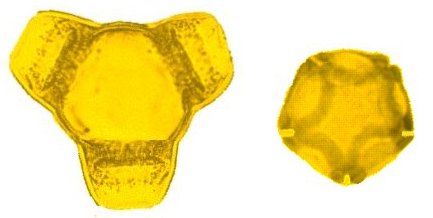Triporate grains

The triporate and stephanoporate (4 or more equatorial pores) pollen grains exhibit a host of variations on a pattern. The grain has three (or more) pores to choose from for germinating, and the variations are useful taxonomic features for identifying the fossil forms.
The grain on the left is from a member of the family Onagraceae, a family that contains perhaps the most unique three and four-pored grains known. The common evening primrose in the western United States is an onagraceous plant that exhibits thread-like projections from the surface of the grains that permit the grains to stick together in long strands. The grain on the right is from Alnus, the alder tree. These grains may contain from four to six equatorial pores, most commonly six. Triporate grains are evident in fossil deposits from mid-Cretaceous to Recent.

The triporate and stephanoporate (4 or more equatorial pores) pollen grains exhibit a host of variations on a pattern. The grain has three (or more) pores to choose from for germinating, and the variations are useful taxonomic features for identifying the fossil forms.
The grain on the left is from a member of the family Onagraceae, a family that contains perhaps the most unique three and four-pored grains known. The common evening primrose in the western United States is an onagraceous plant that exhibits thread-like projections from the surface of the grains that permit the grains to stick together in long strands. The grain on the right is from Alnus, the alder tree. These grains may contain from four to six equatorial pores, most commonly six. Triporate grains are evident in fossil deposits from mid-Cretaceous to Recent.
